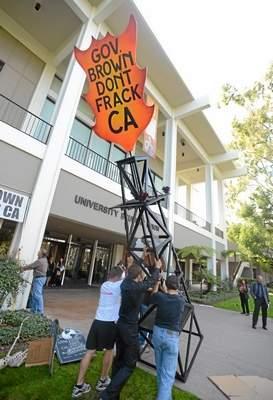
(Stephen Carr / Staff Photographer)
by Andrew Edwards / Press-Telegram
Environmental activists assembled at Cal State Long Beach on Monday to demand an end to the oil and gas extraction technique known as fracking while state officials begin a process to regulate the controversial practice.
The protest attracted about two dozen people, and dozens more attended an on-campus hearing convened by the state’s Division of Oil, Gas and Geothermal Resources to gather public comments on proposed regulations to govern fracking in California.
Fracking is a slang term for hydraulic fracturing, a technique used by the oil and gas industry to inject pressurized water and other chemicals into underground geologic formations to facilitate the removal of oil or natural gas. The action is considered controversial due to concerns of possible contamination of water supplies and increased seismic risks.
“We’re having a funeral for Gov. Brown’s green legacy, because he’s not the governor he says he is,” said organizer Alex Nagy of Food & Water Watch, at the conclusion of the afternoon rally that took place outside the student union.
A prop for the “funeral” included a sign in the shape of a tombstone bearing the message “R.I.P. Gov Brown’s green legacy. Climate leaders don’t frack.”
The protesters’ anger toward Brown was in reaction to his 2013 signing of a bill, SB 4, that calls for California to draft new regulations and a statewide environmental report on the future of fracking in California. The protesters, by contrast, demanded a moratorium on fracking and also called for an eventual abandoning of fossil fuels.
In October, Brown said he saw no contradiction in calling climate change “the world’s greatest existential challenge” while refusing to impose a moratorium on fracking.
“I signed legislation that will create the most comprehensive environmental analysis of fracking to date,” Brown said. “It will take a year, year and a half, maybe a little longer. And I hope that all the people, critics and supporters alike, will participate and offer their best thoughts.”
The issue may not necessarily be settled in Sacramento. On Monday, nine lawmakers, including Assemblywoman Bonnie Lowenthal, D-Long Beach, who is running to be the mayor of Long Beach, sent a letter to the governor asking him to issue an executive order that would create a moratorium on fracking. The letter cites potential harm to the climate, water supply, air quality and heightened earthquake risk as reasons to halt fracking in the state.
“Therefore, we respectfully request that you impose a moratorium on fracking while you fully investigate the science behind fracking for oil production,” the letter concludes.
The U.S. Geological Survey reports that there is a “credible connection” between wastewater injection activities, similar to fracking, near Youngstown, Ohio, and earthquakes in that area, including a magnitude 4 quake on Dec. 31, 2011. The agency also reports, however, that it is unclear whether fluid injection work may instigate a major earthquake.
The Western States Petroleum Association reports that a 2012 study of fracking work in the Baldwin Hills area of Los Angeles found no impacts to groundwater, seismic risks or other environmental concerns. The industry group also states that fracking supports about 21,000 jobs in the state, mostly in the Central Valley.
At Monday’s hearing in an auditorium in the Cal State Long Beach student union, members of the public could express their concerns for the record, although no officials were on hand to reply. The vast majority of speakers spoke in opposition to fracking.
A few speakers, including one man who identified himself as an attorney representing a group called Hispanics in Energy, said officials should consider the possible economic benefits of fracking. He was jeered by audience members after speaking to the responsibility of oil company executives.
“I wish I had a little more respect,” he said.
“I wish you deserved it,” one woman replied.
Fracking does take place in parts of Long Beach where oil is produced, said Kevin Tougas, oil operations manager for the city’s Gas and Oil Department. Fracking activities, he said, are mostly confined to the city’s oil island and have taken place in the city about 190 times.
“We started kind of actively fracking around 1994,” Tougas said.
In Long Beach, wells where fracking takes place are required to be designed so there is no venting of gas to the atmosphere. Fracking is used to extract oil, as opposed to natural gas.
A speaker at Monday’s rally asserted that BreitBurn Energy Partners, a Los Angeles-based oil and gas company, has engaged in fracking at Recreation Park.
The company’s general counsel replied that there are less than 10 operating oil wells at Recreation Park that have been in use for decades. General counsel and vice president Greg Brown wrote in an email that there are numerous safety protocols in place and fracking does not take place at the site.
“The answer is – this is not accurate. We are not engaging in fracking at Recreation Park,” he wrote.
Officials have also scheduled a public comment meeting related to the drafting of a fracking environmental impact report from 4-8 p.m. Wednesday at Long Beach Convention Center.
Staff writer Greg Yee and the San Jose Mercury News contributed to this report.

